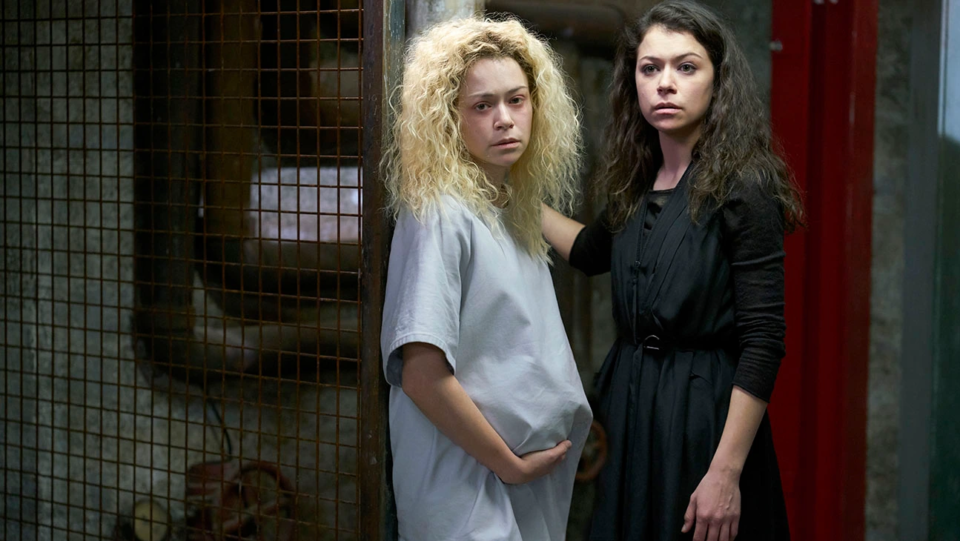The Everlasting Wonder of ‘Orphan Black’

I remember discovering Orphan Black like it was yesterday. I was getting ready to take my final high school exams (similar to the American SATs). At one point, I wanted to take a much-needed break. Everyone on Tumblr (yes, I, too, had a Tumblr) was talking about this new BBC America show. Once I got started, I was hooked and didn’t look back.
In some ways, Orphan Black influenced my current life as I met my wife because of the show. We met on a Facebook group for the series and bonded over our shared admiration of the dynamics between Delphine and Cosima. Even a two-year long-distance relationship while I was finishing my degree wasn’t able to tear us apart. Now, I’m an immigrant in Los Angeles, a freelance writer, and a happily married woman with two dogs. As March 30th marks the show’s 10th anniversary, it’s time to revisit this extraordinary sci-fi show created by Graeme Manson and John Fawcett and reflect on its legacy.
It’s challenging to sum up Orphan Black in just a few words. The story begins as Sarah Manning (Tatiana Maslany), a small-time robber, witnesses a suicide at the local train station in the show. As terrifying as it is, the case is also quite unusual in that the person who jumped is an exact representation of Sarah—like a twin. In a split-second decision, Manning plans to replace Beth who turns out to be a police officer. While executing her scheme, Sarah discovers that she and others have been the subject of human cloning and are, in fact, clones. As Sarah goes down the rabbit hole, the woman meets other “sisters” who want to fight for their freedom and the right to live their lives as they see fit rather than as science experiments.

One of the show’s main and most controversial themes is bodily autonomy, which corresponds to what women continue to face regarding abortion restrictions both in the United States and internationally. Despite Orphan Black being released ten years ago, this main topic remains relevant, despite the passage of time. However, it should be noted that the characters fighting against the system and the people who wish them ill also exhibit strong feelings of empowerment. The show motivates people to fight for the right to decide about their bodies.
The series also shines with its diverse LGBTQ+ representation. Cosima Niehaus, one of the clones, is an eccentric queer scientist. “My sexuality is not the most important thing about me,” she says in one episode. The sentence lingers in the mind as Maslany’s Cosima develops into a well-crafted, complex, dynamic character who also just happens to be a lesbian. As Cosima falls in love with Delphine Cormier (Evelyne Brochu), first known as a “monitor” working for DYAD—the company attempting to control the clones—Orphan Black gives the audience and its queer fans one of the best, most elaborate LGBTQ+ love stories seen in television. Once the scientist becomes involved with Cosima, Delphine becomes an integral member of the “Clone Club” and contributes to discovering a vaccine for a mysterious disease that affects Cosima and may attack other “sisters.”
LGBTQ+ themes also manifest themselves in Felix (Jordan Gavaris), the flamboyant and clever foster brother of Sarah Manning. Both were adopted by Siobhan Sadler, aka Mrs. S (Maria Doyle Kennedy) when they were kids. The foster family is yet another influential theme that makes Orphan Black a timeless show. Through Mrs. S and her foster kids, the series illustrates and represents all kinds of families, reminding the audience that it’s not DNA that makes a family, but love and nurturing.
The topics discussed above are even more impressive and memorable thanks to the incredible cast ensemble, particularly Tatiana Maslany’s remarkable, out-of-this-world performances. Maslany seamlessly transitions from one clone to another. Each character has a distinct personality and ways of thinking and speaking. Although the sisters are clones, they are distinct from one another, which the actress expertly emphasizes. Maslany, known for Marvel’s She-Hulk, does an excellent job of bringing them to life. You won’t see a single person playing multiple roles when watching the show. You’ll see individual characters, each with their own set of struggles, all depicted as multidimensional and dynamic. The actress, along with the supporting cast, particularly Gavaris, Kennedy, and Brochu, delivers performances that are well worth your time and are still relevant years later.
Orphan Black also has many memorable scenes. One of them, without a doubt, is what is now known as “The Clone Dance”. In the season two finale episode, Cosima begins dancing, having previously moved the table and other obstacles from the center of Felix’s artsy loft. In the show’s then-two-season history, the audience saw all four main characters together for the first time. The sisters and family members perform the dance-off to Adham Shaikh’s “Water Prayer (Matt the Alien remix)”. Even in a fleeting moment of happiness for them, we can see how the sisters’ dancing styles differ from one another.

But, regarding the show’s main topic, we must mention the scene in a series finale episode, in which Cosima presses “send” after she and Delphine gather all the information on DYAD’s abuse of power and forward it to the police. Shortly thereafter, Cosima sobs in Delphine’s arms. She feels relieved and emotional as if a heavy weight has been lifted from her chest.
Some directors and writers have an uncanny ability to endow their audience with a show or film that will be watched for years to come. Creating a movie or series that remains relevant and unaffected by the passage of time is no easy task. Nonetheless, Orphan Black demonstrates that it’s possible. Even ten years after the show first aired, the series stays as influential as ever, providing the audience with a well-crafted story, romance, compelling themes, and Maslany’s best, most unique characters to date.
Categorized:Editorials News

